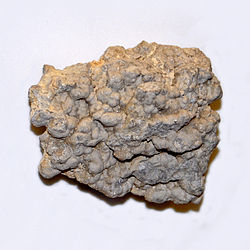| Rotzo Formation | |
|---|---|
| Stratigraphic range: Pliensbachian ~ [1] | |
 Panorama of the Rotzo area with several of the Outcrops visible: Tonezza mountain at the left, Val d´Assa cliff in the center-front and Campolongo mountain in the right | |
| Type | Geological formation |
| Unit of | Calcari Grigi Group |
| Sub-units | Tovel Member [2] |
| Underlies | Massone Oolitic Limestone |
| Overlies | |
| Area | Trento Platform |
| Thickness | 250 m |
| Lithology | |
| Primary | Lithified gray silty marl, gray grainstone, bioturbated/intraclastic/ooidal gray wackestone, mud banks and sand deposits. [3] |
| Other | Light-grey to yellowish-grey packstone with oolites, bioclasts, algal lumps, pellets, dasycladacean algae, foraminifera, lituolids, and miliolids |
| Location | |
| Location | Vicenza Province: Trentino-Alto Adige, Southern Alps |
| Coordinates | 45°42′N11°06′E / 45.7°N 11.1°E |
| Approximate paleocoordinates | 32°06′S16°42′E / 32.1°S 16.7°E |
| Region | Veneto |
| Country | Italy |
| Type section | |
| Named for | Rotzo |
The Rotzo Formation (also known in older literature as the Noriglio Grey Limestone Formation) is a geological formation in Italy, dating to roughly between 192 and 185 million years ago and covering the Pliensbachian stage of the Jurassic Period in the Mesozoic Era. [4] Has been traditionally classified as a Sinemurian-Pliensbachian Formation, but a large and detailed dataset of isotopic 13C and 87Sr/86Sr data, estimated the Rotzo Formation to span only over the Early Pliensbachian, bracketed between the Jamesoni-Davoei biozones, marked in the Loppio Oolitic Limestone-Rotzo Fm contact by a carbon isotope excursion onset similar to the Sinemu-Pliens boundary event, while the other sequences fit with the a warm phase that lasts until the Davoei biozone. [1] A more recent work reinforced this datation, constraining the lowermost levels to 192.30 Ma and the uppermost to 185.99 Ma. [5] The Rotzo Formation represented the Carbonate Platform, being located over the Trento Platform and surrounded by the Massone Oolite (marginal calcarenitic bodies), the Fanes Piccola Encrinite (condensed deposits and emerged lands), the Lombadian Basin Medolo Group and Belluno Basin Soverzene Formation (open marine), and finally towards the south, deep water deposits of the Adriatic Basin. [6] The Pliensbachian Podpeč Limestone of Slovenia, the Aganane Formation & the Calcaires du Bou Dahar of Morocco represent regional equivalents, both in deposition and faunal content.
Contents
- Paleoenvironment
- Amoebae
- Foranimifera
- Invertebrates
- Sponges
- Anthozoa
- Bryozoa
- Brachiopod
- Bivalves
- Ammonoidea
- Gastropoda
- Echinodermata
- Arthropoda
- Annelida
- Ichnofossils
- Vertebrata
- Chondrichthyes
- Actinopterygii
- Crocodyliformes
- Dinosaurs
- Flora
- Amber
- Algae
- Equisetales
- Lycophytes
- Pteridophytes
- Corystospermales
- Caytoniales
- Erdtmanithecales
- Cycadophyta
- Bennettitales
- Ginkgoopsida
- Conifers
- Bibliography
Fossil prosauropod tracks have been reported from the formation. [7] This formation was deposited within a tropical lagoon environment, similar to modern Bahamas which was protected by oolitic shoals and bars from the open deep sea located to the east (Belluno Basin) and towards the west (Lombardia Basin). It is characterized by a rich paleontological content. It is notable mostly thanks to its great amount of big aberrant bivalves, among which is the genus Lithiotis , described in the second half of the nineteenth century. The unusual shape of Lithiotis and Cochlearites shells, extremely elongated and narrow, characterized by a spoon-like body space placed in a high position, rarely preserved, seems to suggest their adaptation to soft and muddy bottoms with a high sedimentation rate. [8] The Bellori outcrop displays about 20 m of limestones with intercalated clays and marls rich in organic matter and sometimes fossil wood (coal) and amber. The limestones are well stratified, with beds 10 cm to more than one metre thick, whereas the clayey levels range between 3 and 40 cm in thickness. [9] [10]










































































